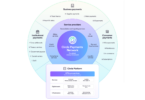Today CLS announced that its blockchain foreign exchange netting solution CLSNet went live with Morgan Stanley and Goldman Sachs as initial clients. Six other clients have committed to the service including Bank of China (Hong Kong). The plan is to gradually onboard new clients. CLSNet was developed in conjunction with IBM.
Since 2002 CLS has played an important role in foreign exchange markets. CLS has an existing FX netting and settlement system called CLS Settlement that processes $5 trillion in foreign exchange payments daily. It is considered systemically important by US regulators. However, that system only deals with 18 major currencies. For example, it does not include the Chinese renminbi.
The new CLSNet system deals with most of the other currencies, 120+ in total. Given the increasing importance of emerging markets, that’s a big win. It’s also quite open, so hedge funds, brokers and even corporations can use it. The system supports most types of forex transactions, not just spot or next day. Thus it includes forwards, NDFs and swaps.
“A standardized and automated payment netting process will lead to improved intraday liquidity, reduced cost, improved operational efficiencies and ultimately support business growth,” said Alan Marquard, Chief Strategy and Development Officer, CLS. In a statement, the company said that the current lack of standardization and automation introduces risk and operational inefficiencies.
Morgan Stanley echoed the sentiment. “CLSNet will deliver the standardization and automation needed for non-CLS settled transactions,” said Adam Josephart, MD, Fixed Income Division.
CLSNet is fundamentally different in structure to CLS Settlement in that CLS’s role is not quite as central. To understand the difference, it’s worth exploring CLS Settlement (the non-DLT system).
CLS Settlement
CLS’s role in the settlement process has several benefits. Firstly, when two banks exchange currency there’s a counterparty risk – that one of them may not deliver. For CLS Settlement, by inserting CLS in the middle so that each party pays CLS, the transaction has finality, and the risk of non-performance disappears.
Secondly, because of CLS’s central role, an institution can do net settlement with CLS rather than settling each transaction. For example, one deal might involve Bank A paying Bank B $100,000 and receiving GBP 135,000. In a separate transaction, Bank A receives $90,000 and pays CAD 120,000.
Instead of paying for each of the transactions, for the US dollar aspect Bank A can pay CLS $10,000. That’s important for liquidity because Bank A doesn’t need to keep the $100,000 in an account waiting for the settlement.
How CLSNet differs
The new CLSNet system is a bilateral system without CLS sitting in the middle of the settlement process. Payments are made party to party, and will often use SWIFT. That means there is potential for counterparty settlement risk. However, one can imagine a future where the currencies are digital, enabling payment finality without CLS as a central counterparty. The company is rumored to be a participant in the Utility Settlement Coin institutional stable coin project.
Concerning netting, this will occur only between the same counterparties. Today netting outside of CLS Settlement is sometimes managed using spreadsheets, so this provides efficiencies. It will also provide a single system where a bank can check all its trades with all counterparties.
Other benefits include standardized payment netting cut-off times.
Because the system uses Distributed Ledger Technologies (DLT) it should be possible to automatically reconcile payments. However, that will only work if all transactions in a bank account use the system. When SWIFT conducted DLT tests one of the biggest issues it encountered was the lack of segregated bank accounts meant reconciliation increased.
A shared DLT should cut down the need for communication, because each party can just check the blockchain.
CLS is involved in multiple blockchain initiatives. The most ambitious is another initiative with IBM called LedgerConnect which aims to provide numerous sets of blockchain functionality for the financial sector. Perhaps the highest value one is derivatives post-trade and settlement.
It’s also an investor in R3 and is rumored to be one of the 17 members of the Utility Settlement Coin institutional stable coin project.
The technology used for CLSNet is Hyperledger Fabric.
The Hyperledger Global Forum takes place in Basel, Switzerland on 12-15 December. Ledger Insights is a media partner, and this code will provide a 20% discount: HGF18LEDGER






